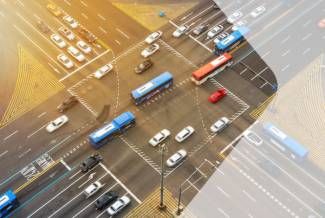Corporate Mobility Management
A large proportion of everyday CO₂ emissions are the fault of commuter traffic - all the more reason why we should focus on corporate mobility management to lay the foundations for new mobility and a more sustainable future. What does corporate mobility management mean and what opportunities does it offer for companies? What measures can be considered for this? And how can it improve our future in the long term?
In the following, you will find the answers to all these questions and gain insight into the opportunities that corporate mobility management can offer - as well as the challenges that still need to be overcome.
Corporate mobility management:
Definition
Mobility management is an essential approach to meeting current and future mobility challenges. After all, the path to a more sustainable future requires fundamental changes in our behavior. Mobility management is designed to do just that: It serves to raise general awareness of sustainable transport options and their value - and thereby drive them forward.
Operational mobility management does this - as the name suggests - at the operational level.
- It refers to the strategic planning, organization and implementation of measures in companies to make employee mobility more sustainable.
- These measures are designed to optimize traffic and promote environmentally friendly transport options.
Why is this so important? Millions of people still go to work by car almost every day. The resulting daily commuter traffic is a burden on the environment that should not be underestimated. Companies can help reduce this aspect of environmental pollution with the help of targeted measures.
The other side of the coin: public sector mobility management. You can also find more information on both concepts in our guide to mobility management in general.
How can you implement modern mobility concepts in companies?
What options are there for promoting mobility within a company? That depends entirely on the company in question, the available budget and the general possibilities.
In principle, corporate mobility management measures can affect various aspects of a company. These include:
- the mobility of employees on their way to work
- the more sustainable design of business trips and journeys
- the optimization of the vehicle fleet or fleet of vehicles
Accordingly, there are also approaches to action with different focus areas, from technical to infrastructural to organizational and informational.

By the way: Anyone who wants to introduce corporate mobility management measures in their company and is looking for a starting point can use the "mobil gewinnt" platform as a valuable resource.
- This initiative of the German government aims to strengthen corporate mobility management in Germany.
- Here you will find information on current funding programs, numerous practical examples and much more relevant information.
There are different types of applications of corporate mobility management: In some cases, only individual measures are used, while in others detailed corporate mobility concepts are created. In addition, there is now also the option of seeking advice from specialized mobility consultants when planning measures.
In the following section, you will find out which measures can be considered for corporate mobility management.
Corporate mobility management:
Measures
The following corporate mobility management measures are only a selection of potential options:

- Job tickets for employees: Providing discounted or free tickets for local public transport encourages the use of environmentally friendly means of transport.
- Efficient parking management: Traffic jams in the parking lot at peak times and long searches for a free parking space increase CO₂ emissions. Parking solutions for companies can optimize parking management in the long term.
- Carpooling and car sharing: Companies can establish programs and platforms to promote carpooling and support car sharing options to reduce the number of vehicles on the road.

- Company-owned rental bicycles or e-scooters: To promote environmentally friendly transportation alternatives for shorter distances, company-owned bicycles or e-scooters can be made available for loan.
- Secure bicycle parking and changing facilities: To motivate employees to come to work by bike, secure bike parking is of course a must. But appropriate changing facilities should also be provided.
- Home office options: The option to work from home for at least part of the week naturally reduces the number of road users. But the home office option also offers employees a better work-life balance.

- Charging infrastructure for e-cars: The installation of charging stations for electric vehicles at the workplace promotes the use of electromobility and enables employees to conveniently charge their vehicles.
- Fleet optimization: Company-owned vehicles can be phased out where possible or replaced with more environmentally friendly alternatives. Innovative options such as e-mobility in the vehicle fleet help to optimize company mobility.
All of these options have already proven effective and are accordingly considered standard measures. But of course, creativity and innovation are also required in corporate mobility management, and new measures are constantly being tinkered with.
Benefits of corporate mobility concepts
Planning mobility concepts in the company and implementing corresponding measures brings many advantages. Although each conversion process requires time and resources, the benefits outweigh the costs in the end. These include the following, among others.
An important contribution to environmental relief
Corporate mobility management aims to promote sustainable transport options within the company. This can reduce daily CO₂ emissions and the company's ecological footprint. Because, of course, switching to alternative means of transportation helps relieve traffic congestion and reduce environmental impact in the long run.
Increased employer attractiveness
Implementing mobility concepts in the company signals commitment to sustainability and environmental protection. This can increase attractiveness as an employer and appeal to potential applicants who share these values. A positive image as an environmentally conscious company can also help retain existing employees and strengthen employee loyalty.
Higher employee health and motivation
Corporate mobility management that focuses on active mobility such as cycling or walking promotes physical activity among employees. Regular exercise can improve the health and well-being of the workforce and lead to higher motivation. By creating a more pleasant and healthier working environment, companies can also increase job satisfaction and positively influence the working atmosphere.
Another advantage is that there are now more and more funding programs for corporate mobility management from which companies can benefit.
Challenges for corporate mobility management
Of course, corporate mobility management also faces challenges that must be overcome. These include:
- lack of infrastructure (e.g., charging stations for electric vehicles, etc.) and low financial resources
- professional and data protection-compliant collection of employee-related data for evaluation purposes
- lack of employee acceptance due to lack of communication and justification.
These and many other potential difficulties must be overcome before corporate mobility management measures can be successful. But it is not only in the operational context that mobility management must overcome challenges. After all, finding the path to the mobility of the future also requires solutions that go far beyond the operational level.
Concrete solutions by SWARCO
Conclusion: Corporate mobility management for a more sustainable future
Every day, millions of people travel to work by car, which places a massive burden on the environment. In order to take the first steps toward a new mobility, such behavior patterns must be optimized. Corporate mobility management can make an important contribution to this - because mobility concepts for companies provide the first approaches to sustainably improving our future.
Last but not least: The only way to achieve the mobility of the future is through change - and this change must occur in every area of life, including our professional lives. Targeted corporate mobility management is an important approach to making this part of our lives more sustainable.
FAQ
Corporate mobility management has many advantages - for companies, employees and for the environment. It is a strategic approach for companies to enable more environmentally friendly and efficient mobility and, accordingly, an important contribution to reducing the burden on our environment. Corporate mobility management measures can be implemented with the help of subsidies, among other things.
There are many proven measures to promote mobility in the workplace. These include:
- Job tickets for employees
- Car pooling and car sharing
- In-company rental bicycles or e-scooters
- Charging infrastructure for e-cars
- Secure bicycle parking and changing facilities
- Home office options
- More environmentally friendly alternatives for company vehicles
- and much more.
Employee mobility refers to the way employees travel to their workplace. Optimizing it is one of the core tasks of corporate mobility management - which aims to make employees' journeys to work as efficient and environmentally friendly as possible, thereby reducing CO₂ emissions.
The mobility of the future will revolutionize the way we get around through technological innovations and alternative means of transportation. With the help of Big Data, artificial intelligence and other innovative solutions, safety for road users can be increased and environmental impact reduced.
More and more companies are implementing corporate mobility management. There are accordingly many best-practice examples of successfully implemented measures. However, one campaign stands out in particular due to its incredibly broad scope: the Germany-wide and cross-company summer campaign "By Bike to Work," in which more than 300,000 people participated in 2023.
Bilder: © stockbusters – stock.adobe.com; © Andrey Popov – stock.adobe.com; © Marius V/peopleimages.com – stock.adobe.com; © arneaw – stock.adobe.com

STAY INFORMED
GET OUR NEWSLETTER!
Subscribe to our ITS / Smart Mobility Newsletter and receive regular updates on trends, developments, solutions and events.





